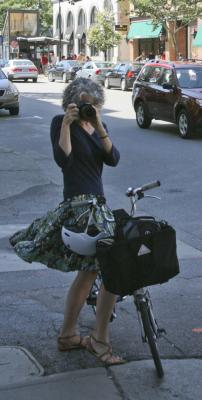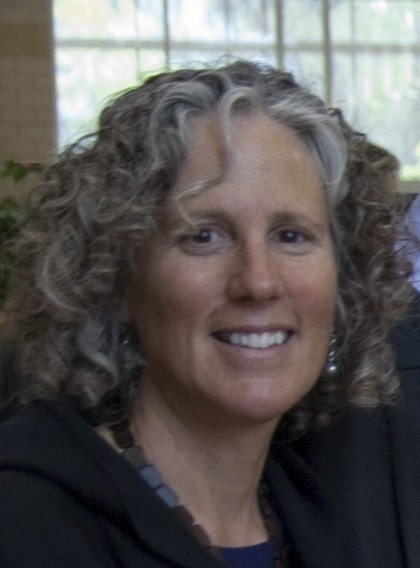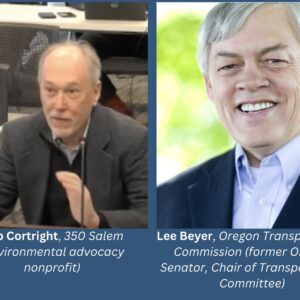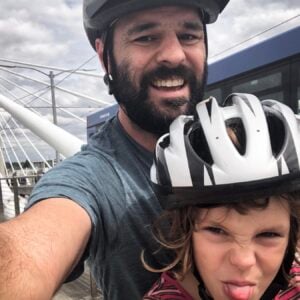Julie Campoli’s mission is to convince the world that Portland is, more or less, right.
In her books, Campoli makes the case that density is desirable, mixed-use neighborhoods are the best ones, and designing streets for walking and biking is good for everyone — even if it reduces auto travel speed and volume, because it’ll foster proximity which is key to healthy behaviors. Free auto parking, on the other hand, hurts the economy by making proximity expensive.
For Portlanders (not to mention BikePortlanders) things were reaching dangerously high levels of self-reinforcement. So in advance of her free talk tomorrow in inner Northwest Portland, The Real Estate Beat decided to ask Campoli about six reasons her arguments might be wrong.
Here’s what she said.
Your new book Made for Walking opens with the story of the Hurst family who live north of Vancouver, Wash, and drive 627 miles a week among them to get to work and school. Do you know why they choose to live in Venersborg despite the drive? Does their choice have any lessons for us?
According to Darcy, they live in Venersborg because they love the quiet rural setting. Many people just feel happier living in the country, and like the Hursts, are willing to make sacrifices to be there. But there are also a large number who would like more attractive urban options, including the Houston family I wrote about, who is in the process of relocating to a walkable town in New Hampshire. Perhaps the lesson is that if we build it, they will come, but certainly not everyone.
The book talks about the many social costs of mandatory auto parking and showers Portland with praise for not requiring it in buildings near transit stops. Sorry — we just changed that. Apartments were popping up everywhere and the neighbors were furious. What were we supposed to do?
You are not alone. Boston is experiencing the same backlash. Keep plugging along and expect that there will be growing pains in a transition that will take a long time.
You devote a chapter to the Pearl. For a lot of people here, that’s code for “neighborhood I can’t afford.” Or for poor folks, “even longer waiting lists than usual.” Can walkable urbanism ever be affordable to the working class?
My purpose was to show a range of dense urban neighborhoods in different regions of the country. The Pearl is a great example of how to create a new urban neighborhood by extending the existing street grid onto vacant industrial land. The message is not that the Pearl model should be applied across the Portland metro region. It’s just one way to build a walkable neighborhood. Keeping housing in the affordable range as neighborhoods improve is always a challenge but some cities have made inroads. The Cambridge example in the book features a large equity housing development that maintained the socioeconomic diversity of a neighborhood that has been trending upscale.
Many, many people prefer not to share walls or yards with neighbors. Is there a place for them in your ideal city?
Yes, the latest Realtor surveys confirm that while most Americans still want a single family home, they are willing to live in a smaller one if it’s in a convenient neighborhood. In order for the neighborhood to be “convenient” meaning it has stores and some transit, the parcels must be small so that densities remain above 7 units per acre. Backyard granny flats (accessory units or garage apartments) help to fill up a neighborhood with people while keeping the scale small and prices more affordable.
Portlanders tend to agree with the sort of things you say. How much of that is because we’re smug, how much because we’re self-interested, how much because we’re a self-selecting sample and how much because we know this stuff actually works?
I won’t speculate on whether Portlanders are smug or self-interested but they surely know by now that designing for people not cars brings great benefits. The thing that strikes me about Portlanders is that they seem to have a greater interest in and support of urban planning than residents of other US cities. Building an urban transit system and pedestrian city in the late 20th century (as opposed to inheriting one from the 19th century) was no small feat and it could not have happened without a population comfortable making plans and sticking with them.
What’s the most convincing argument you’ve ever heard that you might be wrong about all this stuff?
I might be wrong that global demand for oil will increase gas prices, forcing us to shift away from automobiles and toward more transit. New sources of oil, electric cars, driverless vehicles, or whatever, may extend the dominance of the single-occupant vehicle, making it more difficult to build walkable places.
Campoli speaks 5:30 to 7:30 pm Thursday, Jan. 30, at the Center for Architecture, 403 NW 11th Ave. As part of the 1000 Friends of Oregon McCall Speaker Series, the event is free and open to the public. The Portland Bureau of Planning and Sustainability and Metro are also co-hosts.
— The Real Estate Beat is a weekly column. You can sign up to get an email of Real Estate Beat posts (and nothing else) here, or read past installments here. We are looking for a sponsorship partner. If interested, please call Jonathan at (503) 706-8804.









Thanks for reading.
BikePortland has served this community with independent community journalism since 2005. We rely on subscriptions from readers like you to survive. Your financial support is vital in keeping this valuable resource alive and well.
Please subscribe today to strengthen and expand our work.
Great article. I am contemplating RSVPing for the event. Thanks Jonathan. I particularly like your last question and Campoli’s answer:
I know a few regular commenters are going to partially disagree with me on this one. Campoli is right to be worried about this. The “New Urbanism” movement or what ever it is that we are and people that think like us, needs to be very busy right now. Yes, peak oil is coming, but…. natural gas supplies are not at peak and along with electric there may be other technologies that could perpetuate auto dominance. Currently, there is not a much infrastructure for the whole automotive world to switch to something else. All the eggs are in the gasoline/diesel distribution system. The time to make real advance in urban design and transportation policy leading into the coming crisis before another energy source gains dominance.
This is an important point, as it related to the optimistic decline of private passenger vehicles. While you are correct that the current infrastructure is oriented to gas/diesel, it will be a relatively painless transition to electric vehicles for most people that still want to have a car. In urban areas, the range of electric vehicles has been compatible with commutes for over 20 years. The infrastructure for electric cars is even more widespread, as there is electric service everywhere and charging station prices will continue to decline to where they are just another household appliance. If anything, this will lead to more structured parking, and real value (and revenue) extracted from streetside parking in situations where there is also an adjacent charging station. The future of transportation will be electrified…and hopefully pedal -powered as well.
True on the electric. Of course shorter distance, smaller, lighter electric would be an improvement from many perspectives. Even natural gas, for more powerful heavier vehicles could make the transition. More difficult than electric.
Even for electric, what we need is to get inside the door of policy on these decisions so that modes other than private vehicles are integrated in the transition before the transition happens.
Thing to keep in mind is fuel source/sustainability is only one conundrum of auto crisis. Even if we solve fuel issues there are still factors of impossibility of even maintaining, much less expanding the road and infrastructure needs of car culture. Perpetual fuel sources or even magic bullet solutions to pollution and climate change don’t alter that, and would even make it worse if more people drive. Won’t solve traffic snarl ups or ease the dead zones created by mass vehicle movement/storage. Self- driving cars would force motorists to be more polite, drive slower, stop for lights, make room for others, drive further apart etc. All good, but resulting in longer trips than now even with same volume. So if we have a miracle solution to sustainable fuel and make cars self drive reasonably and safely we still have hug problems not solved by such things. To get livable environments we need to give up notions of everyone having huge metal and glass boxes to move about anywhere and store anywhere at hand in all places. The laws of physics as well as human needs preclude this, regardless of fuel source or safer movement of vehicles.
Which is why smart cities need to be thinking ahead as oil peters out and as VMT is leveled off or dropping. I totally agree that building roads is unsustainable for an urban area and following that path is going to lead to bankruptcy and urban blight where cities don’t wake up. However, I think most of the public is still stuck in car head, even many of those who are choosing to reduce driving. Even talking with young people are the Portland (ok mostly Vancouver) area that are living very car light lifestyle, they aren’t generally thoughtful on these issues. They may be riding fixies and buses, but they are far from being opposed to more freeways and bridges.
This “car head” thinking was a point raised last night at a county presentation to our BPAC about an expressway planning process. (Where I live now VMT is going up radically due to business growth and density expansion). We were reviewing alternatives for a grade separation plan for Lawrence Expressway in Sunnyvale/Santa Clara, CA. While we all agreed that a “vision 2040” plan needs to consider anticipated shifts in transportation/technology, the county administrator had a good point: the cities themselves are working to grow and develop and attract both families and businesses, while asking the county to minimize and contain traffic and enhance safety. I don’t envy this planner: these goals are mutually exclusive, and the best she can do is define various transportation ‘corridors’ and last-mile solutions and make sure the implementation yields the safest results by thoroughly vetting the plan iterations with as many interested parties as will contribute their time and effort to listen and review.
Electric vehicles in urban traffic settings are nice…no directly released emissions, less motor heat and noise…but at least so far, electricity required to be produced to power motor vehicles, doesn’t much look like it’s going to be very free from the limitations of available fossil fuel resources.
Increases in number of people living in given areas, is likely to play a big part in increasing the development of walkable communities, regardless of whether petro fuel or electricity is the power source of personal vehicles used to travel between them…because the road can hold only so many vehicles.
Some people seem to forget that electricity production relies a lot on coal fired plants like the one out in Boardman, Oregon, that burns up and produces various emissions from something like 30 train cars of coal a day.
You nailed it. The transition to natural gas is about profitability, despite it being marketed as sustainability and national security. Single-occupant electric vehicles still take up the same space and cause the same congestion, throughput, and safety challenges for planners as gas autos, and the coal or NG used to power them still carries the same negative impacts on the environment – with NG the pollutants shift from the air (smog) to the water supply (contamination from fracking).
“…Single-occupant electric vehicles still take up the same space and cause the same congestion, throughput, and safety challenges for planners as gas autos, …” Pete
Road widening as efforts to continue enabling people to live too far away from work, school, shops to get there by walking, biking, or transit, will contribute to replication of the congestion, throughput, and safety problems of roads like 185th out in Washington County. And then of course, there’s also Hwy 217 from Hwy 26, south to the Tigardl exit, which everyday during rush hours, becomes somewhat of a stagnant parking lot.
I’d love to hear more about the future direction portland is heading with regards to creating walkable, bikable neighborhoods in places that don’t quite fit that mold today.
Portland is in the midst of updating their Comprehensive Plan, and I worry that the zoning mechanisms necessary to create these places are not really being used in the places that need them most.
I’m afraid the Planning & Sustainability Bureau is being pretty timid about zone changes. Given past backlash, they’re not doing much rezoning at all (unlike the 1980 Comp Plan, which did huge amounts). Less walk- and bike-friendly places that are relatively close in, like Southwest, are not getting upzoning along major streets. Folks there don’t want that, nor, according to a recent Tribune article, do they want new streets connected to Barbur Blvd., either. Apparently these sorts of changes were dialed back during the Southwest plan process years ago, because of neighborhood outcry. And in outer SE, they’re hearing “no zoning changes until you rebuild all the streets”. So because of the lack of funds, that may not happen either. And where the amount of residents IS increasing (along Division, Williams, etc.), which will lead to more walkable neighborhoods simply because of demand for more services, which will increase the number of walking and biking destinations, the existing residents are fighting those increases, and asking for down-zoning, or other means to limit the number of new (multi-family?) residences.
Excellent exchange. Thanks Michael.
I’m impressed with her last response–the thing she might be wrong about. I’ve long doubted that “peak oil” will translate to “peak car.”
Carl,
can you say more about that?
By some measures we’re experiencing both right now (world oil production has been essentially flat since 2005, and US VMT has declined incrementally but steadily since 2004). I wouldn’t suggest that the two are necessarily causally linked, but the coincidence is noteworthy.
Switching to electric cars is a nice idea but no one’s been able to tell me how we’re going to produce all those extra kWh should we one day manage to trade in our fleet of gas guzzlers for Nissan Leaves. Electricity isn’t a source of energy; it is a very expensive means of converting (typically fossil fuels) into something that can turn a shaft, run a computer, or play music.
Not to mention the finite (or at least getting hard to find) resources, like lithium, used to make batteries, and (neodymium?) electric motors. Even lead for lead-acid batteries, is not plentiful enough to run the entire US fleet of vehicles, I hear.
Unfortunately the biggest barrier to using other energy sources to support the personal vehicle habit, isn’t technology or supply, it is infrastructure. Even right now, we are very near the point where the main advantage of gas/diesel is in infrastructure. Liquid Natural Gas supplies are increasing (and indeed the US is looking to export LNG out of Northwest ports). Right now, big fleet systems are converting to LNG. It is better than gas for CO2 emission and cheaper. Developing infrastructure to deliver LNG to consumers everywhere is the primary barrier. This is mostly a matter of building it, although it is a bit more involved to transport than gasoline.
The point, is that we can’t just assume that peak oil is just going to automatically make private vehicle use drop dramatically. The auto industry and “car head” thinking will try to resist. At least in Urban and suburban areas we need to influence government and planners to not subsidize this transition and to use the window of opportunity to emphasize other transportation modes.
Private vehicles will probably remain abundant on the road, but we can hope to strike a more sensible balance with more transit and active transportation in urban areas, and hopefully more long distance rail between cities.
These are softball questions, with a dash of perfunctory skepticism thrown in. Pretty much preaching to the choir here.
What are your hardball questions?
How about a follow-up to the comment about the “sacrifices” that those poor, auto-dependent people make to live in suburban or rural areas. Do you think that people who live in the Pearl ever wonder about the sacrifices they have made to live in a dense urban setting? I mean, that’s a lot of money for a small space, right?
Or: How is the book being received outside of the bubble-cities, inhabited by people who believe that everyone believes that density is always desirable, mixed-use neighborhoods are the best ones, and free auto parking is bad?
Michael Andersen has a good point about dangerously high levels of self-reinforcement.
Great questions, Rainbike. It was an email interview and due to some poorly timed communications we got the answers last night, so follow-ups weren’t possible here. Good reason to show up tomorrow and ask!
Thanks, but I should probably actually read one of her books first. I enjoy the perspective and stories that you’re bringing to bikeportland.
Just want to clarify… “suburban” and “rural” do not always equate to “auto-dependent.” Not saying you were implying this, but I see it again and again here on BP comments so I just wanted to reiterate.
What do you say to people who want to live close to city amenities, yet still want space for their gardens, their families, and their pets? Should density be forced on neighborhoods where the majority of residents don’t desire it?
Don’t the taxes I pay fund the street in front of my house, and doesn’t that give me the right to park there?
What studies can you cite that support your view that dense, mixed-use neighborhoods lead to healthier behaviors, and how do you quantify quality of life?
(Not saying I agree with these points of view, I just would like to have seen a slightly more devil’s advocate’s approach.)
“What do you say to people who want to live close to city amenities, yet still want space for their gardens, their families, and their pets? …” Lazlo
Better designed high density that offers those things. People need to be doing a better job of asking what the objective of high density is. Where developers of high density believe there isn’t a market for high density housing close to city amenities, that offers space for gardens, families and pets, they’re not going to build housing that offers those things. It can be done, if people are prepared to pay for it.
Doesn’t matter how many amenities and perks it has, living in the city isn’t ever likely to be able to duplicate the experience of living in rural setting. Especially when housing in the country is cheaper than housing in the city, that becomes a big justification for affording the enjoyment of living in the country, even if it involves driving many miles more than would be necessary if living in the city instead.
Please add this to the discussion of terminology for this topic…the continued use of the term “density” is critically both a red flag for many potential allies and also poorly describes the true outcome our profession is working towards.
For example, density really best describes the half measure: dense housing but not much more…and is often single use high tower blocks in a sea of low density parking or other mono-space. Think of the 1960s Auditorium Blocks or the Lloyd District in both in Portland. (Both are being recreated with a new generation of infill based on better bike and transit investment.)
A better term for our objective is “vitality”….density with activity/ multi use spaces. This can be 4 and 5 storey (think DC or Paris) dense multi use neighbourhoods or taller buildings in city centres without the surface parking.
I should say that I also asked Campoli a question about density but cut it from the final list because I thought it got a little wonky. But here’s what she said:
“You can measure the density of anything by dividing a number count by a measured area, such as persons per acre, housing units per acre, building floor area per parcel, jobs per acre, parking spaces per parcel. These ratios express population density, residential density, building density, parking density, employment density, and parking density, which are just a few ways to gauge the activity of a place.”
Hi Michael…my request for adding ‘vitality’ to the conversation was primarily addressed to Campoli for future public discussions.
Portland did kind of inherent a 19th Century urban form with its short blocks that- in addition to density- was one of the four conditions of vibrancy that Jane Jacobs cites in The Death and Life of Great American Cities.
Just to point out, Portland’s basic urban form comes from the late 19th and early 20th centuries. In 1918 we had one of the best rail transit systems in the country, vibrant neighborhood commercial districts, and walkable streets. Even in my youth you could take the interurban streetcar from downtown to Oregon City; in 2015, MAX will only get to Milwaukie.
We trashed that system and fell in love with Robert Moses of NYC and ringed our inner city with freeways and destroyed half a dozen neighborhoods in the process.
If Portland has a story, its what happened in the 70’s…trading the Mt Hood freeway for MAX, removing Harbor Drive, building the transit mall, and trading a parking structure for Pioneer Courthouse Square. Too bad we have such a hard time keeping this going in the 21st century!
“…If Portland has a story, its what happened in the 70’s…trading the Mt Hood freeway for MAX, removing Harbor Drive, building the transit mall, and trading a parking structure for Pioneer Courthouse Square. Too bad we have such a hard time keeping this going in the 21st century!” Lenny Anderson
The vision seems to have waned. It’s mind boggling how, when presented with what, from a planning perspective, is essentially is a fresh slate, officials often seem to forge straight ahead into development that creates the kind of nightmare conditions the defeated Mt Hood Freeway project would have created for Portland. I hope people in Washington county can wake up to the potential for this happening, before it’s too late to reverse that direction taken.